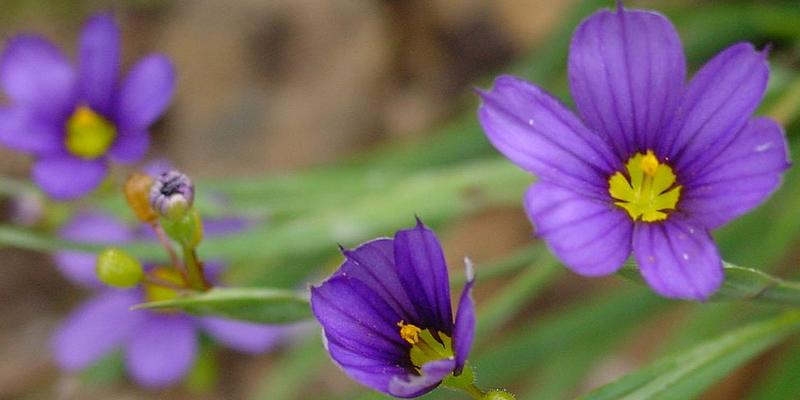Thirteen new native plant species have been added to the Oregon Threatened and Endangered Plants list. Our colleagues at the Oregon Department of Agriculture (ODA) recently sent out the following notice. A full list of Oregon’s Threatened and Endangered Plants can be found here. This notice is also included in Spanish below.
– quoted information begins here –
ODA formally added eight endangered and five threatened species to the State’s list of threatened and endangered plants, effective June 8, 2023.
Thirteen new native plant species have been added to the Oregon Threatened and Endangered Plants list. (From top, clockwise: Erigeron stanselliae, Lathyrus holochlorus, Lomatium ochocense, Meconella oregana, Sisyrinchium hitchcockii)
The Oregon Department of Agriculture Native Plant Conservation Program (ODA) is responsible for the periodic review of the Oregon State List of Endangered and Threatened Plants (OAR 603-073-0060 & 0070). In 2022 and early 2023, ODA worked with federal and state agencies in Oregon, Washington, California, Nevada, and Idaho, local Oregon governments, non-profit organizations, and citizens to collect population data, threat information, and gain an understanding of the species’ current condition from those most familiar with each species. For each species, ODA presented information on 1) habitat and ecology, 2) geographic range, distribution, and abundance, 3) factors affecting survival, and 4) current condition (i.e., representation, resiliency, and redundancy) to a Technical Advisory Committee in January and February 2023.
Following a public comment period, the species below have been added to OAR 603-073-0070:
Endangered Native Plants
Arabis mcdonaldiana Eastw. – McDonald’s rockcress;
Collomia renacta E. Joyal – Barren valley collomia;
Erigeron stanselliae K.L. Chambers – Stansell’s daisy;
Gilia millefoliata Fisch. & C.A. Mey. – Seaside gilia;
Lathyrus holochlorus (Piper) C.L. Hitchc. – Thin-leaved pea;
Lomatium ochocense Helliwell & Constance ex Helliwell – Ochoco lomatium;
Navarretia willamettensis S.C. Spencer – Willamette navarretia;
Sisyrinchium hitchcockii D. Henderson – Hitchcock’s blue-eyed grass
Threatened Native Plants
Astragalus lemmonii A. Gray – Lemmon’s milkvetch;
Howellia aquatilis A. Gray – Water howellia;
Meconella oregana Nutt. – White fairy poppy;
Monardella angustifolia Elvin, Ertter & Mansfield – Leslie Gulch monardella;
Pinus albicaulis Engelm. – Whitebark pine
Effective June 8th, 2023, it is unlawful to take, import, export, purchase, sell, collect material from, store, preserve, possess, cultivate, propagate, knowingly transport, or attempt any of these actions for any of the above listed plants on non-federal public land in Oregon without a written permit (see OAR 603-073-0100 for more details). Information on consultations and permitting can be found online here. Species specific technical information will be available soon.
– – – – – – – – – – – – – – – – – – – – – – – – – – – – – – – – – – – – – – – – – – – – – – – – – – – – – – – – – – – –
Se han añadido 13 especies a la lista estatal de plantas amenazadas y en peligro de extinción de Oregon
El Departamento de Agricultura de Oregon añadió formalmente ocho especies en peligro de extinción y cinco amenazadas a la lista estatal de plantas amenazadas y en peligro de extinción, con efecto a partir del 8 de junio de 2023.
El Programa de Conservación de Plantas Autóctonas del Departamento de Agricultura de Oregon (ODA por sus siglas en inglés) es responsable de la revisión periódica de la Lista Estatal de Plantas Amenazadas y en Peligro de Oregon (OAR 603-073-0060 & 0070). En 2022 y principios de 2023, el ODA trabajó con agencias federales y estatales en Oregon, Washington, California, Nevada e Idaho; gobiernos locales de Oregon; organizaciones sin fines de lucro; y ciudadanos para recopilar datos de población, información sobre amenazas y obtener una comprensión de la condición actual de las especies de aquellos que están más familiarizados con cada especie. Para cada especie, el ODA presentó información sobre 1) hábitat y ecología, 2) rango geográfico, distribución y abundancia, 3) factores que afectan a la supervivencia y 4) estado actual (por ejemplo, representación, resistencia y redundancia) a un Comité Asesor Técnico en enero y febrero de 2023.
Después de un período de comentarios públicos, las especies que se indican a continuación se han añadido a OAR 603-073-0070:
En peligro
Arabis mcdonaldiana Eastw. – McDonald’s rockcress;
Collomia renacta E. Joyal – Barren valley collomia;
Erigeron stanselliae K.L. Chambers – Stansell’s daisy;
Gilia millefoliata Fisch. & C.A. Mey. – Seaside gilia;
Lathyrus holochlorus (Piper) C.L. Hitchc. – Thin-leaved pea;
Lomatium ochocense Helliwell & Constance ex Helliwell – Ochoco lomatium;
Navarretia willamettensis S.C. Spencer – Willamette navarretia;
Sisyrinchium hitchcockii D. Henderson – Hitchcock’s blue-eyed grass
Amenazadas
Astragalus lemmonii A. Gray – Lemmon’s milkvetch;
Howellia aquatilis A. Gray – Water howellia;
Meconella oregana Nutt. – White fairy poppy;
Monardella angustifolia Elvin, Ertter & Mansfield – Leslie Gulch monardella;
Pinus albicaulis Engelm. – Whitebark pine
A partir del 8 de junio de 2023, es ilegal tomar, importar, exportar, comprar, vender, recolectar material, almacenar, preservar, poseer, cultivar, propagar, transportar intencionalmente, o intentar cualquiera de estas acciones para cualquiera de las plantas mencionadas anteriormente en tierras públicas no federales en Oregon sin un permiso por escrito (Consulte OAR 603-073-0100 para obtener más detalles). La información sobre consultas y permisos puede en encontrarlas en línea aquí. La información técnica específica de la especie estará disponible pronto.
Suscríbase a las actualizaciones de NPCP
Contact
Oregon Department of Agriculture
Native Plant Conservation Program
Email us: listedplants@oda.oregon.gov | Call: 503-986-4621

